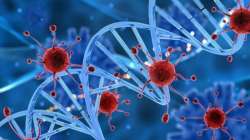US scientists develop a contact lens that can diagnose cancer from tears. Know how
The lens was designed with microchambers bound to antibodies that can capture exosomes found in tears. This antibody-conjugated signaling microchamber contact lens (ACSM-CL) can be stained for detection with nanoparticle-tagged specific antibodies for selective visualisation.

US scientists have developed a contact lens that can help in the early detection of cancer using tears and help in the treatment. The novel lens, developed by the team at the Terasaki Institute for Biomedical Innovation (TIBI) in California, is able to capture and detect exosomes, the nanometer-sized vesicles found in bodily secretions that have the potential for being diagnostic cancer biomarkers.
The lens was designed with microchambers bound to antibodies that can capture exosomes found in tears. This antibody-conjugated signaling microchamber contact lens (ACSM-CL) can be stained for detection with nanoparticle-tagged specific antibodies for selective visualisation.
This offers a potential platform for cancer pre-screening and a supportive diagnostic tool that is easy, rapid, sensitive, cost-effective, and non-invasive.
Exosomes are formed within most cells and secreted into many bodily fluids, such as plasma, saliva, urine, and tears. Once thought to be the dumping grounds for unwanted materials from their cells of origin, it is now known that exosomes can transport different biomolecules between cells.
But, the TIBI team devised their ACSM-CL for capturing exosomes from tears, an optimum and cleaner source of exosomes than blood, urine, and saliva.
"Exosomes are a rich source of markers and biomolecules which can be targeted for several biomedical applications," said Ali Khademhosseini, TIBI's Director and CEO. ALSO READ: Cancer disappears in patients 'first time in history' after drug trial; Deets inside
"The methodology that our team has developed greatly facilitates our ability to tap into this source."
In an initial validation experiment, the ACSM-CL was tested against exosomes secreted into supernatants from ten different tissue and cancer cell lines. The ability to capture and detect exosomes was validated by the spectroscopic shifts observed in all the test samples, in comparison with the negative controls.
Similar results were obtained when the ACSM-CL was tested against ten different tear samples collected from volunteers.
In final experiments, exosomes in supernatants collected from three different cell lines with different surface marker expressions were tested against the ACSM-CL, along with different combinations of marker-specific detection antibodies.
The resultant patterns of detection and non-detection of exosomes from the three different cell lines were as expected, thus validating the ACSM-CL's ability to accurately capture and detect exosomes with different surface markers.